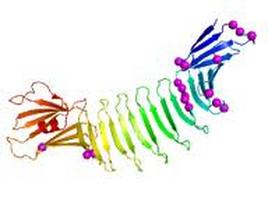Outer Surface Proteins

Borrelia burgdorferi outer surface protein A
The outer membrane of Borrelia burgdorferi is composed of various outer surface proteins (Osp) that range from Osp A to OspF. They are said to play a role in the virulence, transmission and survival of the tick. Most of these outer surface proteins are Osp A and Osp B. The genes encoding these proteins are written from a common promoter and are located on a 49 kb linear plasmid. The Borrelia burgdorferi chromosome is almost 1100 kb in size.
OspA, OspB, and OspD are expressed by B. burgdorferi staying in the gut of unfed ticks, suggesting they promote the persistence of the spirochetes in ticks between blood meals. B. burgdorferi During transmission to the host, when the nymphal tick feeds and the spirochetes in the midgut multiply rapidly, most spirochetes stop expressing OspA on their surfaces. When OspA diminishes, OspC is expressed and migrates to the salivary gland where it impairs the function of dendritic cells.
OspE and OspF are present in B. burgdorferi strain N40. The OspE and OspF genes are structurally arranged as one transcriptional unit under a common promoter. The presence of multiple OspE and OspF proteins allows Borrelia burgdorferi to avoid killing by the alternative complement pathway of a broad range of potential animal hosts.
OspA, OspB, and OspD are expressed by B. burgdorferi staying in the gut of unfed ticks, suggesting they promote the persistence of the spirochetes in ticks between blood meals. B. burgdorferi During transmission to the host, when the nymphal tick feeds and the spirochetes in the midgut multiply rapidly, most spirochetes stop expressing OspA on their surfaces. When OspA diminishes, OspC is expressed and migrates to the salivary gland where it impairs the function of dendritic cells.
OspE and OspF are present in B. burgdorferi strain N40. The OspE and OspF genes are structurally arranged as one transcriptional unit under a common promoter. The presence of multiple OspE and OspF proteins allows Borrelia burgdorferi to avoid killing by the alternative complement pathway of a broad range of potential animal hosts.
